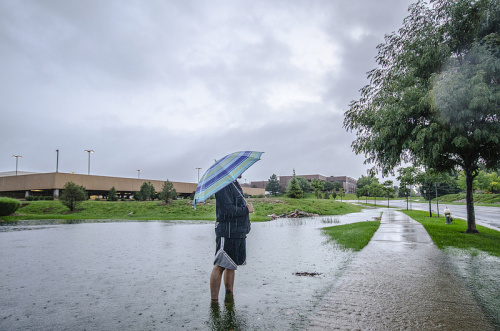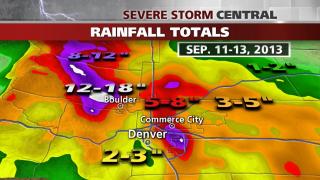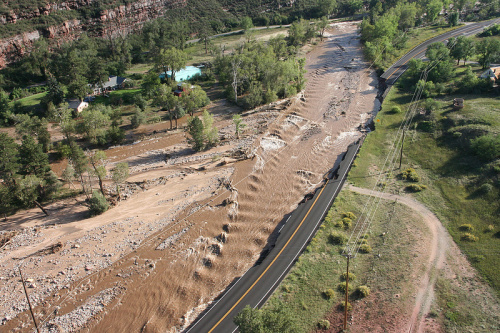You may remember SparkFun was closed on September 12th and 13th due to rain and flooding events in Boulder, Co. This was the first ever "rain day" for SparkFun that applied under our snow day rules. It was a crazy time for a lot of people and there was just too much water for most people to come into work. Luckily a couple people were able to come to SFE so we could capture this awesome photo.
Our "rain day(s)" were labeled as a 1000 year rainfall event. That doesn’t mean that every 1000 years on the dot there is a ton of rainfall. It just means there is a .1% chance in a given year that much rainfall will occur at one time. At this point, you are probably asking, well, how much rain was there?
There were about eight days that led to just over 18 inches of rain. This is over half of our annual precipitation in Boulder that came in just over one week! Since it had rained in the days before the big event, the soil became saturated. On September 12th, with just over 9 inches of rain that day, the water flowed over the soil causing the flash flooding.
The Weather Channel
Colorado gets monsoon rain annually that typically ends in August. This year, it continued into September. The system came from the Pacific Ocean just West of Mexico moving North over the mountains causing an upslope effect. Basically, when the air flows uphill, it expands and cools, causing the moisture to fall as rain. The storm hovered over the Western slope and central mountains for a while before moving into the Front Range. Before the rain, a high-pressure system caused record temperatures in the Boulder area. The warmer air means more moisture can be held. So when this high-pressure system shifted, the following monsoon rains moved in with low-pressure and more rain than expected.
Faculty from the University of Colorado at Boulder and the National Oceanic and Atmospheric Administration (NOAA) estimated the flooding to be a 25-50 year flood event. It is estimated to be $2 billion in damages with many structures labeled damaged or destroyed.
CDOT SH 7 2013
Here's what happened over those few days:
- People unaccounted for: 0
- Deaths: 4
- Homes destroyed: 354
- Homes damaged: 557
- Commercial properties damages: 33
- Commercial properties destroyed: 3
- Total properties assessed: 5,592
- People evacuated by air: 1,102
- People evacuated by road: 707
- Miles of roads damaged: approx. 150
- Cost to replace damaged roads: $100 million - $150 million
- Cost of damage to city infrastructure, parks and open space: $49 million
~All came from the Boulder County Office of Emergency Management~
With FEMA’s help there were many disaster assistance programs set up in vacant buildings. So far FEMA has given $4.2 million with 446 claims paid and 1,964 claims total.
If you remember, SparkFun also did a donation day to help out all those who could use it. On September 23rd we donated 10% of our sales to the United Way Foothills Flood Relief Fund. Not only that, but Elevations Credit Union matched us in our donation. Thanks to you guys, internal employees and SFE matching (and Elevations Credit Union) all together, we raised $35,218.
Thanks again to all who helped donate that day!










I am live/work in Longmont (north of Boulder for those that don't know), and what really impressed me was each city's OEM did a fantastic job closing roads that were dangerous, and keeping people safe until the National Guard and FIRST Responders could help evacuate everyone that were stranded.
I am also extremely impressed that companies were taking all necessary precautions to keep employees safe. For an example, Thursday afternoon, my office only had maybe 12 people totally (out of about 210) still in the office. Out of those 12, half could get home (we live within walking distance of the office), the others were able to get hotel rooms or stay with co-workers (thanks to the coordination of our site manager and company as a whole).
What really restored faith in humanity for me was the fact that so many people were willing to donate time to help others. Monetary donations are one thing, but the communities coming together as a whole was really impressive.
Since you mentioned SparkFun's "snow day rules", I can't help wondering what they are.
We follow the lead of the Boulder County School District, adding our screams of joy to those of all the kids out there.
Except that.... BVSD had four days off.... but in reality, only the first two were for rain. The second two (Monday and Tuesday) were because most of the BVSD school buses were being used to evacuate the town of Lions. Hey Spark Fun, thanks for the Redboard starter kit!!! It is sure nice to feel appreciated, but now that I'm back at work (and n+16 days behind...) I'm not sure when I'll get a chance to play with it...
Thanks for doing a followup on your fundraising and the calamity in general. It is nice to understand the scale of what you guys were dealing with and know how much money you guys were able to raise, Good Job!
Here is an explanation for the reasons behind the increase of extreme weather events: ClimateState - Extreme Weather {July 2013}
Hmm...something with a 0.1% probability per year should probably be called a 693-year event, as that's when the probability of it happening at least once crosses 50%. Not terribly comforting when you can call the event "Last Month", however. Good luck to your community with cleanup; we here in New England understand your challenges.
Can you explain the math? This sounds like an interesting probability problem. Something like 1000*ln(2)?
Yes, I think that is part of the reason why the powers-that-be keep trying to discourage use of terms like "1000-year event", but it is so much easier to say and sounds cooler than either 0.1% or 693 year event.
To tristan, maybe it is just me, but I find it much easier to look at probabilities like this from the other side. Instead of what is the chance of it happening, what is the chance of it not happening. For the 0.1% event, there is a P=0.999 probability it will not happen this year. Chance it will not happen this year AND not happen next year is just 0.999 x 0.999. Not happen three years in a row is 0.999^3. The point TomC is making is that 0.999^693 is about 0.5 so after 693 years the thousand year event in some sense becomes "likely".
RJS (Another Boulder resident. Yesterday I just got the house heating back on after the flood.)
These statements seem to have little recognition of the effect that humans have on the system in question (along with other less obvious factors). Climate change is already having something of a visable impact on life now (in Ireland/UK here anyway) with colder winters and warmer summers. Every season seems to be hotter or colder than any on record, and one can only imagine what this will do if we extrapolate it out to a scale of 500 years or so. To not factor these into equations before making statements like a one in a thousand year event seems a bit foolhardy.